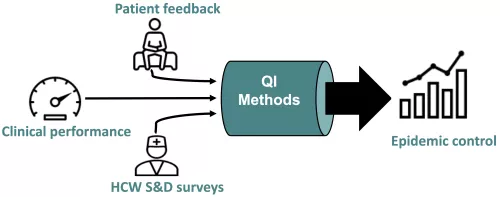What is the solution?
The Southeast Asia Stigma Reduction QI Learning Network (QIS+D Network) was launched in 2017 by HEALTHQUAL with support from PEPFAR and has been continued with support from Gilead Sciences and ViiV Healthcare. QIS+D aims to accelerate the integration of S+D reduction activities into routine HIV quality management programming through cycles of continuous measurement, implementing improvements, and peer-to-peer exchange. To support Ministries of Health and the implementation of S+D reduction activities, HEALTHQUAL provides expert consultation related to performance measurement, QI capacity-building, scale-up, and coaching strategies. QIS+D currently convenes Ministries of Health from Cambodia, Lao PDR, Thailand, Vietnam, Malaysia, and the Philippines.
|
Table 1. Commmon S&D Indicators |
|
1.Have you observed HCW colleagues unwilling to care for a PLWH in your health facility? 2.Have you observed HCW colleagues providing poorer quality of care to a PLWH in your health facility? 3.Do you typically wear double gloves when providing care to PLWH? 4.Do you typically avoid contact when providing care to a PLWH? 5.Do you strongly agree, agree, disagree, or strongly disagree that women living with HIV should be allowed to have babies? 6.Do you strongly agree, agree, disagree, or strongly disagree that there are adequate supplies in your facility to reduce your risk of being infected with HIV? 7.How worried are you about getting HIV if you drew blood from a PLWH? 8.Does your facility have written guidelines to protect PLWH from discrimination? |
Continuous measurement
As part of Network activities, health facilities in participating countries measure HIV-related S+D among healthcare workers (HCW) on a continuous basis using common indicators from a validated survey tool (Table 1). In addition, these facilities routinely collect data on patients’ experience and treatment literacy through structured questionnaires, patient fora, and clinical encounters.
QI methods
Using data from HCW surveys, patient feedback, and clinical performance data, facilities apply QI methods (e.g., process mapping, PDSA cycles) to identify root causes of suboptimal outcomes and implement contextually tailored interventions to improve identified gaps. A more robust concept of quality of care is formed through this process in which S+D reduction activities and people-centered service delivery are explicitly aligned with 95-95-95 targets (Figure 2).

Peer-to-peer learning and exchange
Teams from participating Ministries of Health are convened quarterly by UCSF HEALTHQUAL to share successes and challenges and co-create implementation strategies. During these meetings, participants discuss the translation of policy into data-driven practice at the facility level and develop plans for scale-up and sustainability based on experiences from peers and content experts.